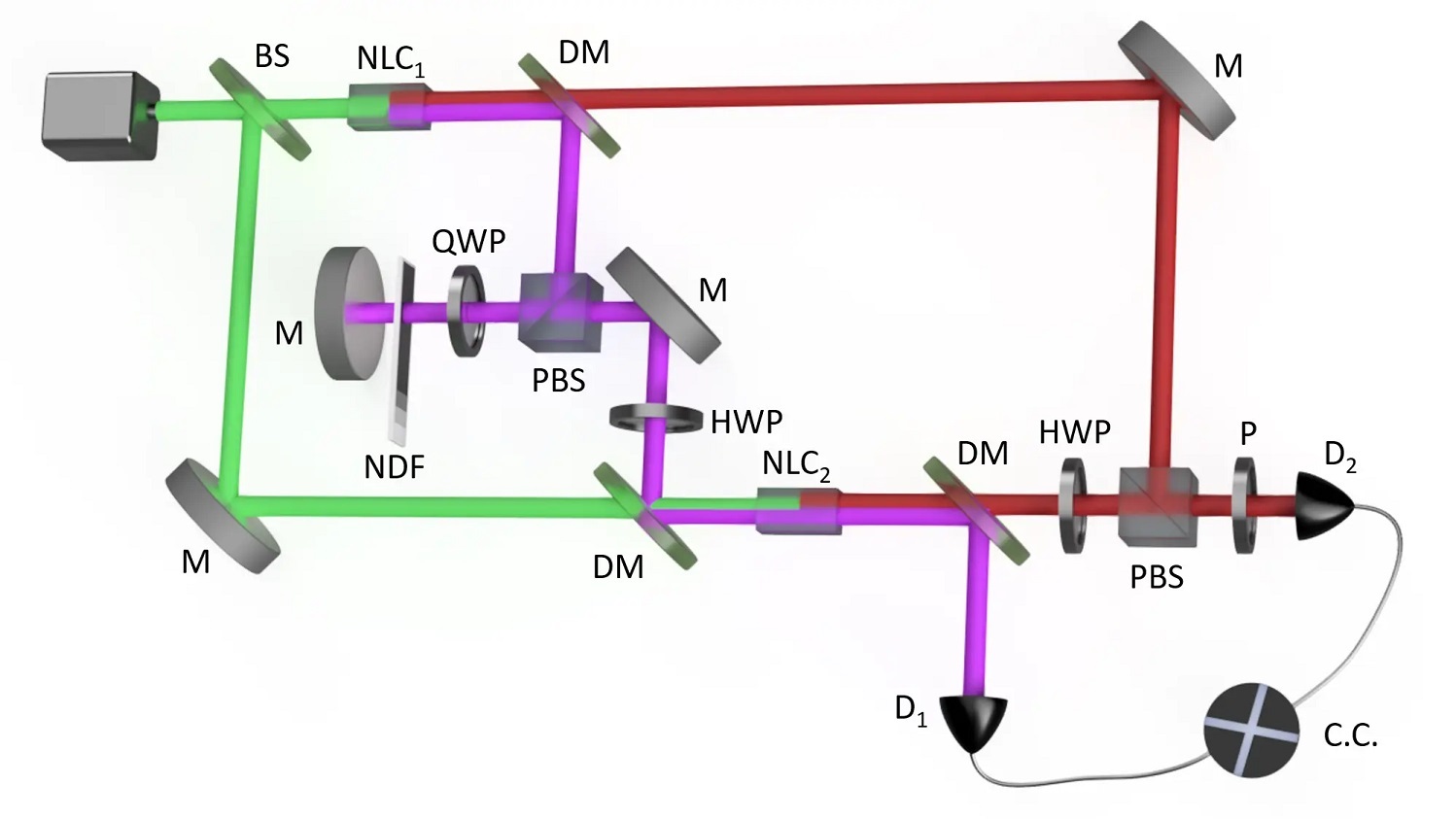July 29, 2024
ICFO researchers have derived and experimentally verified a new complementarity relation for quantum interference in induced coherence experiments valid for both low and high photon-flux rates, extending to the latter the applicability of quantum coherence and photon distinguishability concepts.
Quantum mechanics, a realm of surprising and counterintuitive phenomena, has fascinated scientists for decades. At its core lies quantum interference, a concept famously exemplified by the double-slit experiment, which showcases the concept of wave-particle duality. In this experiment, a quantum particle (like a photon, an electron or an atom) passes through two slits and impacts a screen, creating (after various repetitions) an interference pattern of bright and dark bands, indicative of wave-like behavior.
Being a breakthrough at the time, now we know that this phenomenon is explained by the wave-particle duality, which establishes that quantum entities exhibit particle or wave properties depending on the experimental circumstances, and that it occurs only when there is no way of knowing which slit the particle passes through.
Since then, many variations of these experiments have arisen and been demonstrated experimentally. Some of them go a step further and demonstrate a so-called complementarity principle, according to which quantum entities can go from wave-like to particle-like behavior in a continuous way.
In general, the degree of quantum interference is measured by the visibility of the interference fringes, but visibility is not always a suitable choice. That is the case, for instance, of those experiments based on the concept of induced coherence when the flux rate of the photons sent is beyond the single-photon regime. In these scenarios, new measures and complementarity relations are needed.
Now, ICFO researchers Dr. Gerard J. Machado (also member of the Imperial College of London), Lluc Sendra and Dr. Adam Vallés, led by ICFO and UPC Professor Dr. Juan P. Torres have derived a complementarity relation valid for any photon-flux rate generated in induced coherence experiments. They avoided using visibility and instead employed the concept of “first-order coherence”, a parameter more convenient to measure the wave-like behavior of the photons. Their theoretical findings, experimentally verified in the low photon-flux regime, have been published in Physical Review A.
Induced coherence experiments
The experimental setup involves two second-order nonlinear crystals that are optically pumped by mutually coherent waves to generate a pair of photons, called signal and idler.
The photons follow a particular circuit so that quantum interference occurs at the end of the signals’ route. The key point is that one can tune the probability that the first crystal idler’s path merges with the second crystal idler’s path. When their trajectories are completely aligned, and thus indistinguishable, the origin of the idlers is unknown, and interference fringes form at the signals’ output. Otherwise, the interference pattern disappears because the idler’s path, and consequently its crystal of origin, can be determined.
Complementarity relationships for low and high photon-flux rates
Previous induced coherence experiments mainly worked in the single-photon regime, where visibility is a valid indicator of its wave-like nature. There was a lack of theoretical framework and experimental realizations suitable for the high photon-flux regime though, a scarcity that the ICFO team wanted to address.
In their study, the researchers replaced visibility by the so-called ‘first-order correlation’ function to measure the wave coherence. “In our setup, the first-order correlation function is crucial because it allows us to measure the coherence between the two interfering photons. This coherence is directly related to, but in general not exactly equal to, the visibility of the interference pattern, which in turn depends on whether it is possible to distinguish the origin of the photons”, explains Dr. Gerard J. Machado, first author of the article.
The researchers also introduced a new measure of distinguishability based on second-order correlation functions. By linking the coherence between two interfering photons with the updated distinguishability parameter, they were able to derive a complementarity relationship that holds for any photon-flux rate. This extends the applicability of quantum coherence and photon distinguishability beyond the single-photon regime, offering new insights into the nature of these fundamental concepts.
The team then tested their theoretically derived relationship in an induced coherence experiment in the low photon-flux regime. “We faced various obstacles during the experiment, such as maintaining and optimizing the coherence between the interfering photons and measuring coincidences between photons of different wavelengths, which required using different single-photon detectors. But through iterative improvements in our setup, we obtained the desired experimental results that matched the theoretical model”, shares Dr. J. Machado.
Foundational insights for quantum applications
Adapting the experiment to higher photon-flux rates and extending it to more complex and higher-dimensional quantum systems should be the next steps for the community. Nevertheless, this work already provides foundational insights applicable to various quantum technologies, including quantum communication, computing and metrology.
Prof. Dr. Juan P. Torres highlights the significance of their results: “We have bridged the wave behavior of light (its coherence) with its particle behavior (photon distinguishability), providing a unified framework that is valid across different photon-flux regimes, from single-photon to high parametric gain.”
###
Acknowledgements:
This work is part of the Research and Development Project No. CEX2019-000910-S, funded by MCIN/AEI/10.13039/501100011033/. It is supported by Fundació Cellex, Fundació Mir-Puig, and Generalitat de Catalunya through the CERCA program. We acknowledge financial support from project QUISPAMOL (Grant No. PID2020-112670GB-I00) funded by MCIN/AEI/10.13039/501100011033. This work is part of the project 20FUN02 “POLight,” which has received funding from the EMPIR program cofinanced by the Participating States and from the European Union's Horizon 2020 research and innovation program. G.J.M. was supported by the Secretaria d'Universitats i Recerca del Departament d'Empresa i Coneixement de la Generalitat de Catalunya and the European Social Fund (ESF) FEDER.
Bibliographic reference:
J. Machado, L. Sendra, A. Vallés and J. P. Torres, Complementarity relationship between coherence and path distinguishability in an interferometer based on induced coherence, Phys. Rev. A 110, 012421 (2024). DOI: 10.1103/PhysRevA.110.012421
https://journals.aps.org/pra/abstract/10.1103/PhysRevA.110.012421















